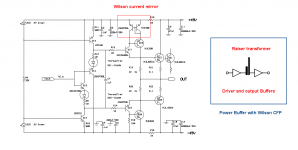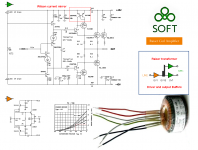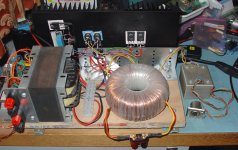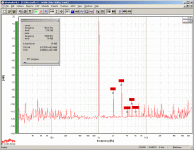A power transformer would not be suitable for an audio output transformer. If it was, the tube guys would be very happy I'm sure. I made a simple small amp of about 5W or so using a couple of audio transformers, a small input and larger output, and two TO-126 BJT's and a Vbe multiplier that adjusted the bias via the centertap of the input transformer secondary. Very simple but the results were as one would expect. Would make a great desktop amp, maybe powered by USB?
I made a simple small amp of about 5W or so using a couple of audio transformers, a small input and larger output, and two TO-126 BJT's and a Vbe multiplier that adjusted the bias via the centertap of the input transformer secondary. Very simple but the results were as one would expect. Would make a great desktop amp, maybe powered by USB?
 I made a simple small amp of about 5W or so using a couple of audio transformers, a small input and larger output, and two TO-126 BJT's and a Vbe multiplier that adjusted the bias via the centertap of the input transformer secondary. Very simple but the results were as one would expect. Would make a great desktop amp, maybe powered by USB?
I made a simple small amp of about 5W or so using a couple of audio transformers, a small input and larger output, and two TO-126 BJT's and a Vbe multiplier that adjusted the bias via the centertap of the input transformer secondary. Very simple but the results were as one would expect. Would make a great desktop amp, maybe powered by USB?I found this thread wanting to build a transformer amplifier based on a pair I had when I was a teen. I had an OLD pair of 6x9 speakers with built-on amplifiers, rated 60W @ 4 ohms!.....and they were LOUD!!! The output "transformer" only had a center-tapped primary winding, and the speaker was connected across the whole primary coil (DC coupled). Due to the push-pull action of the transformer, the output voltage to the speaker was doubled!!! 12V DC in/24V peak signal out (minus losses of course). (Like having BTL x2) The input transformer amplified the voltage, and it had a CT secondary just like the Susan Parker designs, biased by 7.5K ohms feeding two diodes in series. They were designed for 12V, but they were really loud on even a 6V lantern battery, and very low distortion!
I miss them, however I want to build one (or two) transformer amplifier for PA use, or any other use where I can just connect 6 or 12V and get LOUD with no BTL amps or SMPS and have it be reliable and simple. Maybe even having enough power or low impedance drive to use the power transformer as a step-up may be an option.
I'm considering using FERRITE for the transformers instead of iron.....any input on this????
I miss them, however I want to build one (or two) transformer amplifier for PA use, or any other use where I can just connect 6 or 12V and get LOUD with no BTL amps or SMPS and have it be reliable and simple. Maybe even having enough power or low impedance drive to use the power transformer as a step-up may be an option.
I'm considering using FERRITE for the transformers instead of iron.....any input on this????
Using ferrites
Hi Mad Prof,
Most ferrite won't have the inductance in the lower end of the audio band. Generally ferrites start at around 10KHz for usability, some much higher.
It does however very much depend on the specific material type, and there is a huge range of types out there.
You are also limited by size, since core area is determined not just by required power but also frequency.
I am actually doing a HF version of my amplifier which is specifically designed to cover 20kHz to 20MHz (have to finish putting together the test lash-up to see exactly what I will get out of it).
Where you may need ferrites is using a few small beads on the two transformer primary winding legs to stop HF oscillations.
Best,
Susan.
Hi Mad Prof,
I'm considering using FERRITE for the transformers instead of iron.....any input on this????
Most ferrite won't have the inductance in the lower end of the audio band. Generally ferrites start at around 10KHz for usability, some much higher.
It does however very much depend on the specific material type, and there is a huge range of types out there.
You are also limited by size, since core area is determined not just by required power but also frequency.
I am actually doing a HF version of my amplifier which is specifically designed to cover 20kHz to 20MHz (have to finish putting together the test lash-up to see exactly what I will get out of it).
Where you may need ferrites is using a few small beads on the two transformer primary winding legs to stop HF oscillations.
Best,
Susan.
Thanks Susan, I didn't expect to get a reply from YOU!!!!  Awesome!
Awesome!
As you see, the transformer amp has VERY practical uses, regardless what "others" say. I have been following your Zero-Feedback Transformer amp since the beginning.
I've been experimenting with Ferrite CRT TV/monitor Yokes by putting audio signal into them, to see if they would make a good audio transformer. Core size is no limit for me, I have PLENTY of BIG Ferrites. If they are not good for Bass, then making a Bi-Amped system using ferrite transformer amps to drive the tweeters may be an option.
I Also have some very heavy CT Iron Transformers I may use for the output transformers, my biggest problem is getting a suitable input transformer. Most transformers I salvage step up the voltage, but have NO CT which makes biasing a challenge.
Thanks for your input, Susan, and everyone else here at DiyAudio!
As you see, the transformer amp has VERY practical uses, regardless what "others" say. I have been following your Zero-Feedback Transformer amp since the beginning.
I've been experimenting with Ferrite CRT TV/monitor Yokes by putting audio signal into them, to see if they would make a good audio transformer. Core size is no limit for me, I have PLENTY of BIG Ferrites. If they are not good for Bass, then making a Bi-Amped system using ferrite transformer amps to drive the tweeters may be an option.
I Also have some very heavy CT Iron Transformers I may use for the output transformers, my biggest problem is getting a suitable input transformer. Most transformers I salvage step up the voltage, but have NO CT which makes biasing a challenge.
Thanks for your input, Susan, and everyone else here at DiyAudio!
Input Transformers
Hi Mad Prof,
Thanks
For the input transformer you can either use two side by side with common primaries, or a single transformer with a centre tapped load termination resistor.
Note that many mains transformers have split bobbins for line/secondary separation and don't couple well into the higher audio frequencies.
Or two small toroids, although that can be problematical with HF response too.
These will at least get you going.
However note that I find that the critical part for getting really good performance out of the amplifier is in the input transformer and testing between one and another can make the difference between 0.1% and 0.005% THD.
Best wishes,
Susan.
Hi Mad Prof,
Thanks
....
Most transformers I salvage step up the voltage, but have NO CT which makes biasing a challenge.
For the input transformer you can either use two side by side with common primaries, or a single transformer with a centre tapped load termination resistor.
Note that many mains transformers have split bobbins for line/secondary separation and don't couple well into the higher audio frequencies.
Or two small toroids, although that can be problematical with HF response too.
These will at least get you going.
However note that I find that the critical part for getting really good performance out of the amplifier is in the input transformer and testing between one and another can make the difference between 0.1% and 0.005% THD.
Best wishes,
Susan.
Toroid Transformers
Hi Bonsai,
Yes, toroid bandwidth CAN be very high, up into the hundreds of kHz....
BUT they much be specifically designed for purpose, e.g. Plitron, see this book for more information:
Audio Book by Vanderveen | Plitron
BTW Menno Vanderveen is someone who I have actually met and had coffee time with at an AES conference as well as email correspondence and he is very positive about my amplifier topology.
I quote "It was a pleasure meeting you, and seeing your sound approach on audio design, really my compliments."
However...
Just taking a standard mains AC line toroid (e.g. I have tried parts between 30 and 250VA with 115+115 primaries) and using it in my amplifier configuration will typically give at most a bandwidth of a touch over 20kHz. Some smaller ones will be a lot less.
Now 20kHz is fine, particularly for intimal "trying it out on the bench" work, and if one's only music source is listening to download MP3s from iNoise then it may well be absolutely good enough for background non-critical listening (e.g. kitchen or garage workshop).
But otherwise one needs to use very specific core types and winding setups.
I use EI and C core transformers because I can wind them on my winding machines (of which I have three) or manually with hand guided layering on my lathe.
I can and have wound a couple of bespoke toroid PP output transformers by hand with wire pre-loaded onto a winding shuttle (which I made myself from an aluminium tube), but it is hard work and takes a full day just to make one.
I would not try to make a full range audio input or step up toroid transformer by hand, it is just too fiddly.
Best wishes,
Susan.
P.S.
If anyone has an appropriate sized toroid winding machine they can lend or donate to me, I would be very happy to do more work on these.
Note here in this part of London, UK we are on 245 Vac mains supply (yes I know it's meant to be nominally 230 Vac).
And as it is April, at the moment as I write this it is snowing.
Hi Bonsai,
Someone noted here on the forum that the bandwidth of conventional torroids was actually very wide. IIRC and I have my story straight, it was up to 60KHz, and they posted a picture of a set up on a
Yes, toroid bandwidth CAN be very high, up into the hundreds of kHz....
BUT they much be specifically designed for purpose, e.g. Plitron, see this book for more information:
Audio Book by Vanderveen | Plitron
BTW Menno Vanderveen is someone who I have actually met and had coffee time with at an AES conference as well as email correspondence and he is very positive about my amplifier topology.
I quote "It was a pleasure meeting you, and seeing your sound approach on audio design, really my compliments."
However...
Just taking a standard mains AC line toroid (e.g. I have tried parts between 30 and 250VA with 115+115 primaries) and using it in my amplifier configuration will typically give at most a bandwidth of a touch over 20kHz. Some smaller ones will be a lot less.
Now 20kHz is fine, particularly for intimal "trying it out on the bench" work, and if one's only music source is listening to download MP3s from iNoise then it may well be absolutely good enough for background non-critical listening (e.g. kitchen or garage workshop).
But otherwise one needs to use very specific core types and winding setups.
I use EI and C core transformers because I can wind them on my winding machines (of which I have three) or manually with hand guided layering on my lathe.
I can and have wound a couple of bespoke toroid PP output transformers by hand with wire pre-loaded onto a winding shuttle (which I made myself from an aluminium tube), but it is hard work and takes a full day just to make one.
I would not try to make a full range audio input or step up toroid transformer by hand, it is just too fiddly.
Best wishes,
Susan.
P.S.
If anyone has an appropriate sized toroid winding machine they can lend or donate to me, I would be very happy to do more work on these.
Note here in this part of London, UK we are on 245 Vac mains supply (yes I know it's meant to be nominally 230 Vac).
And as it is April, at the moment as I write this it is snowing.
Toroid Output Transformer
FYI here is a pics of a test set-up with the above mentioned hand wound output transformer, plus a FFT for the amp at 2 watts.
The EI on the left hand side is my standard EI120 output transformer, not being used of course for this test but makes for a handy size comparison.
Input transformer on right is Sowter 8160 with 100% Mumetal laminations, in this view mounted in a Mumetal case which I also got from Sowter.
Note the THD at 1kHz is 0.0046% at 2 watts into 8 ohms.
As with all of these types the THD is higher in the LF and HF ends of the audio band, but this does show that the toroids can work just as well as the EI parts. Pity they are such a hassle to wind.
Best,
Susan.
FYI here is a pics of a test set-up with the above mentioned hand wound output transformer, plus a FFT for the amp at 2 watts.
The EI on the left hand side is my standard EI120 output transformer, not being used of course for this test but makes for a handy size comparison.
Input transformer on right is Sowter 8160 with 100% Mumetal laminations, in this view mounted in a Mumetal case which I also got from Sowter.
Note the THD at 1kHz is 0.0046% at 2 watts into 8 ohms.
As with all of these types the THD is higher in the LF and HF ends of the audio band, but this does show that the toroids can work just as well as the EI parts. Pity they are such a hassle to wind.
Best,
Susan.
Attachments
Hi Telstar,
Thanks
Yes, I am still working on the transformer based amplifiers. It's now twenty years since I had the original concept, time does seem to pass quickly.
I have also designed a phono cartridge and I am working on a tube (C3g) based preamp for that so I have been doing a few other audio projects, but as far as the amps go I am still just doing the one thing in it's various permutations (PP, SE, tube hybrid, etc).
Best wishes,
Susan.
Nice to see you still around and active Susan
I read of the Zeus more than 3 years ago.
Thanks
Yes, I am still working on the transformer based amplifiers. It's now twenty years since I had the original concept, time does seem to pass quickly.
I have also designed a phono cartridge and I am working on a tube (C3g) based preamp for that so I have been doing a few other audio projects, but as far as the amps go I am still just doing the one thing in it's various permutations (PP, SE, tube hybrid, etc).
Best wishes,
Susan.
It's now twenty years since I had the original concept, time does seem to pass quickly.
I have also designed a phono cartridge and I am working on a tube (C3g) based preamp for that
Yes, 20 years.....where does it go?
Interesting---is there any info out yet on the cartridge & pre?
Thanks Susan
For Stee: Have you built your power follower, and if so, what are you driving it with----how do you like it?
Best regards to all,
Terry
not yet, i'm working about a strange quasi-balanced method
http://www.esafono.it/quasi-balanced schematic.gif
http://www.esafono.it/quasi-balanced schematic.gif
Phono Cartridge
Hi Terry,
The cartridge is in final testing and characterisation as I find the time (the problem of having a day job is that these other activities can get rather drawn out).
It is however meant to be a commercial product to help cover my costs (I have spent rather a lot on my Zeus audio amplifier project these last ten years) so I am not sure how much I can say here as I don't want to fall foul of the DIY moderators (whom I really appreciate as this forum is one of the few "nice" and "safe" spaces to discuss and encourage our hobby/interests).
Also I am looking at trademarks etc. for the cartridge since it is innovative in design appearance and construction, so have to be circumspect until that side is sorted out.
I can say that initial listening trials with third parties have been very positive.
The down side is that if I do want to have it as a commercial product, it will have to be "reassuringly expensive". The mark up that accumulate from me as a manufacturer through distribution to retail and thence customer is truly scary (particularly when there is a 20% sales tax tacked on).
Anyway, when I have some specifics to show I can ask the moderators for guidance as to what would be appropriate to include here in the DIYaudio forum (in the Analogue Source section I would assume).
The pre is being designed specifically for my cartridge, however it would also work well for most other MC types. My cartridge has an output of around 300uV depending on which test standard one uses.
At the moment it's a three stage design using C3g tubes in push-pull and transformers for input, interstage x 2, and output.
Currently I am using Lundahl parts to make it accessible to other builders (LL1678, LL1660S x 2, LL1689) as well as not trying to do everything all in one go. There are Sowter parts that look to be good equivalents (ST8055, ST9090 x 2, ST9900) but I haven't tried them.
I will in due course probably design my own transformers, but that is some way off.
I am inclined to including switchable time-constants to cover non RIAA equalisation curves since even I with my modest vinyl collection have a number of discs which pre-date the playback standardisation.
Once I have that working, I will (probably) put up some more information on it. For the moment it is still very much at the "on the bench testing segments" stage and I don't want to get confused from too much "helpful" advise.
Best wishes,
Susan.
Hi Terry,
Yes, 20 years.....where does it go?
Interesting---is there any info out yet on the cartridge & pre?
The cartridge is in final testing and characterisation as I find the time (the problem of having a day job is that these other activities can get rather drawn out).
It is however meant to be a commercial product to help cover my costs (I have spent rather a lot on my Zeus audio amplifier project these last ten years) so I am not sure how much I can say here as I don't want to fall foul of the DIY moderators (whom I really appreciate as this forum is one of the few "nice" and "safe" spaces to discuss and encourage our hobby/interests).
Also I am looking at trademarks etc. for the cartridge since it is innovative in design appearance and construction, so have to be circumspect until that side is sorted out.
I can say that initial listening trials with third parties have been very positive.
The down side is that if I do want to have it as a commercial product, it will have to be "reassuringly expensive". The mark up that accumulate from me as a manufacturer through distribution to retail and thence customer is truly scary (particularly when there is a 20% sales tax tacked on).
Anyway, when I have some specifics to show I can ask the moderators for guidance as to what would be appropriate to include here in the DIYaudio forum (in the Analogue Source section I would assume).
The pre is being designed specifically for my cartridge, however it would also work well for most other MC types. My cartridge has an output of around 300uV depending on which test standard one uses.
At the moment it's a three stage design using C3g tubes in push-pull and transformers for input, interstage x 2, and output.
Currently I am using Lundahl parts to make it accessible to other builders (LL1678, LL1660S x 2, LL1689) as well as not trying to do everything all in one go. There are Sowter parts that look to be good equivalents (ST8055, ST9090 x 2, ST9900) but I haven't tried them.
I will in due course probably design my own transformers, but that is some way off.
I am inclined to including switchable time-constants to cover non RIAA equalisation curves since even I with my modest vinyl collection have a number of discs which pre-date the playback standardisation.
Once I have that working, I will (probably) put up some more information on it. For the moment it is still very much at the "on the bench testing segments" stage and I don't want to get confused from too much "helpful" advise.
Best wishes,
Susan.
- Status
- This old topic is closed. If you want to reopen this topic, contact a moderator using the "Report Post" button.
- Home
- Amplifiers
- Solid State
- a transformer as an amplifier




